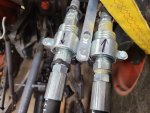The 3rd function valves are usually an industrial solenoid valve designed for subplate mounting. As such the valve only has a P and T port where the T port is rated for nearly the same pressure as the P port. That allows it to power a downstream device. It does not require a relief valve because that function is being provided by the subplate or a loader valve which is also being protected by the main relief in the tractors outlet block. Here is my 3rd function valve. It is a commodity monoblock with power beyond and inlet relief and is plumbed with a tank return and power beyond circuit. Also notice that this particular valve has 3 tank ports so you still have a top and side tank option when the power beyond plug is installed.Question for the obvious experts in this thread, on a related topic: The 3rd function valve I purchased does not have a PB port on it. Its P port connects to the PB port on my loader valve, and then the tank port connects back to the PB port on the tractor, which of course feeds the 3 point. I’ve looked at several 3rd function valves from various companies(Summit, WR Long, etc.) and they all seem to be configured this way. The valves don’t have a relief built in, and they don’t have a PB port. So the questions are 1. With the info noted earlier in this thread, shouldn’t these 3rd function valves have a PB port and relief valve? 2. If not, then why would a rear remote valve need to have a PB port & relief? What’s the difference? Can’t seem to find this answer anywhere. My ultimate goal is to add a rear valve to control a top link cylinder. I already have the electric 3rd function valve for my grapple. So I’m just trying to determine the type/configuration of the valve I’ll need to get for my rear cylinder. Thanks in advance for any advice.
So why do you want a power beyond circuit? The primary answer is in Torch's explanation - the exhaust oil from the actuators (cylinder/motor) goes direct to tank not to the inlet side of a downstream device. This isolates the actuator from down stream loads. When you use the T port to power a downstream device you are putting the actuators on the upstream device in series with the ones on the downstream device - e.g. the output from your grapple cylinder is being used to extend the 3pt cylinder. This can cause unexpected movements of an actuator and possibly create dangerous control scenarios. It also creates the potential for pressure intensification in the rod ends of cylinders that the inlet over pressure relief cannot see and relieve causing cylinder rupture/blowout.
Dan




